Evaluating the Health of Your Horse
Evaluating the Health of Your Horse
Authors: Fernanda Camargo, and Roberta Dwyer, Animal and Food Sciences
Horse owners should strive to maintain the health of their horses, whether they own one recreational horse or run a breeding operation. It is very important that owners, managers, and handlers be able to identify whether a horse is ill. Before you can identify a disease state, you need to know what "normal" looks like for each particular horse. This is probably one of the most valuable aspects of identifying a sick animal. As a horse owner or manager, you need to learn the behavior and personality of each horse, such as facial expressions, eating and drinking habits, pasture friends, pecking order, stall habits, and level of playfulness, to mention just a few. Behavior varies from horse to horse, and what is normal and common for one horse may be abnormal and uncommon for another horse. The importance of learning to know your horse(s) cannot be stressed enough.
Begin this learning process by studying the horse's behavior through observation and inspection. Also, make sure you can accurately determine important measurements such as temperature, pulse, respiration, and mucous membrane color through a clinical examination. Having this information about your horse can be critical if the animal is ill or injured and you need to supply these details to your veterinarian.
Inspection
All the following aspects are part of what we call "inspection," and it simply includes things we can do by observation only, before we touch the horse. Here are some of the questions you should ask yourself as you approach the horse:

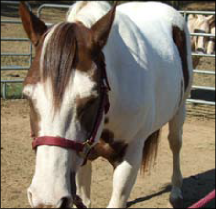
will be uninterested in his surroundings, have no appetite, "will stop drinking water, and will be abnormally lethargic.
Is the horse alert, or is the horse abnormally sleepy/lethargic? It is acceptable for a horse to be taking a nap as you approach it, but most horses start to interact with a person if stimulated. It is not normal for a horse to sleep for hours at a time and be oblivious to any interaction you are attempting to get. If a horse seems too lethargic and does not seem to acknowledge your presence, you can offer the horse a treat or some grain. Most horses are very stimulated by food and should "wake up" when it is being offered.
Here is another chance you have to see how well you know your horse by knowing which treats are most appealing to your horse. Consider that a treat or grain is more enticing to a horse than hay. Do not offer new treats when you are trying to assess his condition because you run the risk that he simply does not like that particular treat, and your assessment of his condition may be confounded. For example, some horses have not been accustomed to eating apples and may not like them the first time they are offered. In this case, if you offer an apple to the horse, he may simply not be interested just because it is an apple. So try offering something that you know the horse likes. Based on his response, you can evaluate his appetite, his alertness, and his normal response toward you.

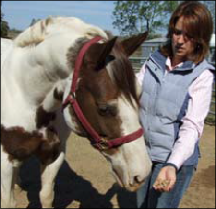
s the horse sweaty although the weather is not humid or hot and the horse has not been exercised? If the horse is inexplicably sweaty, the horse may be showing signs of pain. Many times, horses sweat when they are experiencing colic or abdominal pain.
Does the horse roll too much, look at his abdomen, paw the ground, kick at his abdomen, or grind his teeth? These are all signs of abdominal pain, which is the definition of colic.
Is the horse lying down too much? This may be a sign of colic. But this can also be a sign of laminitis (founder) that, due to the pain in his feet, makes the horse want to lie down more often than normal. A laminitic horse will adopt a different posture as well, extending his legs in front of him and putting more pressure on the heels of the foot, moving the body backward, which in turn moves the center of gravity more caudally. This change in posture is done in an attempt to alleviate the pressure on the toes of the foot.
Clinical Examination
You should perform a clinical examination of your horse on a routine basis so you learn the normal parameters of the horse and also so the horse gets accustomed to being handled.
An important aspect of the evaluation of your horse's health status is verification of vital signs. These are parameters used to evaluate normalcy in animals and humans. The term vital signs means "necessary for life," and the basic vital signs include temperature, heart rate, and respiratory rate.
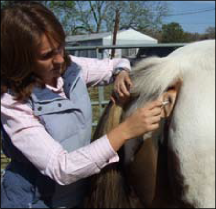
Temperature
Normal temperature in the adult horse ranges from 99.5 to 101.5°F. Younger horses normally have their temperature on the higher end of the range. If a horse has a temperature above
101.5°F, it is hyperthermic (usually due to exercise or a hot environment). If an elevated temperature is due to a disease process, then the horse has a true fever. Horses with fever will change their demeanor by showing lack of interest in food, acting slowly, not drinking water, etc.
Conditions that increase the temperature of the horse include infectious diseases, pain, dehydration, blood loss, pneumonia, colic, etc.
An abnormally low temperature can also indicate a serious problem such as hypothermia from a cold and wet environment or shock.
Taking the Temperature
When measuring a horse's temperature, you should insert a clean thermometer in the horse's rectum. A dab of petroleum jelly or mineral oil will be appreciated by your horse! You should hold the thermometer in place until the reading is complete. The reading time varies for different thermometers. You can use either a digital or a mercury thermometer.
Pay attention to the other signs the horse may be showing in addition to the increased temperature, and if he is showing any additional signs, you may need to call your veterinarian.
Heart Rate and Pulse
As part of the clinical examination, check the heart rate of the horse. The heart rate is how many times the heart beats per minute. The normal heart rate (or pulse) in the adult horse is 25 to 45
beats per minute (bpm). Younger horses normally have higher heart rates than adult horses.
Taking the Heart Rate
You should count how many beats per 60 seconds to get a measurement. You can also count for 30 seconds and multiply the results by 2, or you can count for 15 seconds and multiply the results by 4. It is important to know that by counting for 30 or 15 seconds, you get a good approximation of the heart rate, but it is not as accurate as counting for one minute. You should not count for less than 15 seconds, as the results can be too inaccurate.
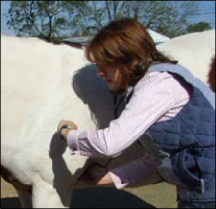

Pulse
There is a difference between heart rate and pulse. Every time the heart beats, blood is ejected out of the heart and into the arteries, and this creates the pulse. Pulse is measured by palpating specific arteries, such as the transverse facial, facial, or digital arteries. When you measure pulse, you should count the pulse for 60 seconds, or you can do it as explained above for heart rate. Pulse is a good approximation of heart rate but may not be the exact number. When measuring pulse, you also want to check if the pulse pressure is normal, weak and fluttery, or pounding.
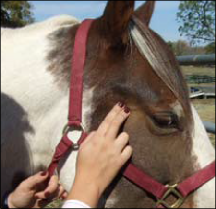
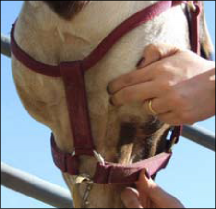
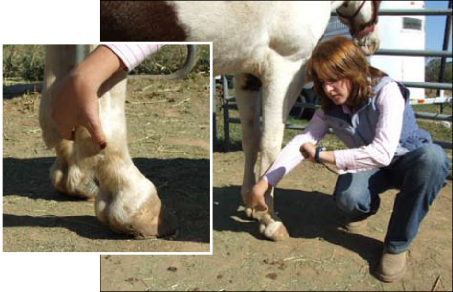
Conditions that will increase the heart rate and pulse include any cause of distress, dehydration, pain, colic, blood loss, or fever. In cases of dehydration and blood loss, the pulse will be weak and fluttery. If the horse shows signs of discomfort, as in colic, and you measure the pulse and it is above 60, you may want to call your veterinarian.
Respiratory Rate
The respiratory rate of a horse at rest should be between 14 to 20 breaths per minute. That number increases if a horse is in distress or in pain or if the weather is hot and humid.

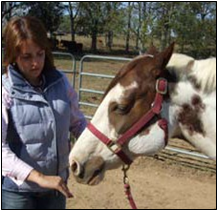

Finding the Respiratory Rate
If you have a stethoscope, place it on the thorax (chest) of the horse and listen for respiration sounds. The respiration sounds are very quiet on a healthy horse, and you will need to train your ears to listen to them.
You can also measure respiratory rate by:
• placing your hand close to the muzzle of the horse and counting how many times you feel the warm breath on your hand (disregard the first few breaths because it is likely your horse will sniff at your hand, giving a false higher respiratory rate);
• placing the stethoscope over the trachea (windpipe) of the horse (the sounds on this location are much louder than over the thorax), or
• looking at the flank of the horse and counting how many times in 60 seconds it expands. This is the least accurate way of measuring respiratory rate because it may be very difficult to objectively observe a resting healthy horse's abdomen move.
Respiratory Pattern
Another very important aspect in assessing the health of your horse is the respiratory pattern. Respiratory pattern is one of the things that can be observed from a distance—not the respiratory rate so much, but the pattern itself. You can hardly see the respiratory movements of horses at rest. Therefore, if you find a horse that is heaving at rest, nostrils flared, in the absence of exercise or hot and humid weather, it may indicate that something is wrong with the horse. He may be developing heaves or a respiratory infection.
A horse at rest should have a very quiet respiration pattern. It is not normal for a horse to be heaving and have very exacerbated respiratory movements without having exercised. If your horse shows an abnormal respiratory pattern or is intolerant to exercise, you need to contact your veterinarian because your horse may be starting to show signs of respiratory or cardiac diseases.

Mucosal Coloration
The next thing you want to check is the mucosal coloration. You do that by checking the membranes (mucosa) on the gums, the eye, and the vulva (in females). The mucosa should be pink, moist, and shiny. Pale mucosa means that the horse is anemic or in shock. Anemia can be caused by acute or chronic blood loss. Acute blood loss can happen because of hemorrhage, and chronic blood loss can happen due to high parasite load or other hemolytic anemias. If the mucosa is dark red, it can mean that there is an infection, dehydration, inflammation, congestion, etc. If the mucosa is bluish (cyanosis), that means that the blood is low in oxygen. This can be due to heart or lung problems.
If the mucosa is too dry, that may mean dehydration. If the buccal (mouth) mucosa is too wet and the horse is drooling, it may mean one or more of these conditions:
- the horse has eaten clover,
- there may be a tooth infection,
- there may be something lodged in his mouth and he is unable to swallow,
- he may have been exposed to toxins, or
- he may have eaten something unpalatable.
Excessive salivation is also a clinical sign of rabies. Always call your veterinarian if your horse shows excessive drooling.
Capillary Refill Time
While assessing the mucosal coloration, you can also measure the capillary refill time. This is done by pressing your thumb over the gum of the horse for 2 seconds and then releasing the pressure. The area where your thumb was will become whitish for an instant and then return to the normal pinkish coloration as the capillaries refill with blood. The time that it takes from being white to being refilled with blood (capillary refill time) should be 2 seconds or less.
Conditions that increase the capillary refill time above 2 seconds include dehydration, infections, fever, blood loss, etc.
Gut Sounds
Gut sounds can be heard by placing a stethoscope anywhere on the abdomen of the horse. Gut sounds are called borborygmi, and they are gurgling sounds. In cases of colic, the gut sounds will be absent, and that is a concern and reason to call your veterinarian. Gut sounds can also be absent right after exercise. It is important for you to listen to normal gut sounds before exercise and after exercise; before, during, and after feeding; and when the horse is just grazing grass or hay. This is so you can train your ears to listen for gut sounds and know when it is time to call the veterinarian.
Conclusion
It is very important to learn how to perform a clinical evaluation of your horse when he is in a normal state. This is important so you know what the normal parameters are and so you can get your horse used to having the different parts of his body handled. You should learn to do these procedures to ensure early detection of disease and to provide vital information to the veterinarian on how critical your horse's case is when you call. Practice makes perfect!
